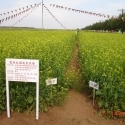09 Oct 2012
Straw returns to field reduce fertilizer rates and increase crop yields
Straw return and nutrient management

Crop residue management is of great importance for its value in improving soil fertility and protecting environment. Among the ways of residue uses, surface mulching on the soil is becoming more and more popular in China. In order to evaluate the rates of NPK fertilizers required by crops under surface mulching of crop residue in wheat - rice rotation, long-term field experiments were conducted in Guanghan, Sichuan province of China. Results showed that consecutive returning crop residue to soil as surface mulching considerably increased crop yields and reduced fertilizer use. Based on the same rates of NPK fertilizers, additional straw mulching increased wheat yield by 13-20% and rice yield by 7-8%. Under straw mulch, P and K fertilizers can be continuously omitted for eight years without any yield losses compared to the NPK treatment (CK) with straw removal from the field. On the contrary, the treatment receiving crop residue with no P application even produced 0.4-19.3% higher wheat yield and 1.3-5.2% % higher rice yield than CK. Similarly, the treatment receiving crop residue with no K application even produced 0.9-16.3 % higher wheat yield and about 3% higher or slightly less rice yield than CK, implying importance of returning crop residue to crop yield. It should be noticed that amending a modest amount of K fertilizer is necessary to maintain high crop yield and soil K reserves after 4-5 years' mulching practice, especially for paddy rice production. The results are very useful in guiding nutrient management in areas using straw mulch, that is, it can save at least up to 20% of N, 60% of P2O5 and 40 % of K2O to produce equivalent amounts of agricultural products in an eight - year period of consecutively straw mulching. In another words, crop resides left on the soil surface can improve soil tilth, sustain soil fertility and crop yield, and reduce fertilizer rates.




